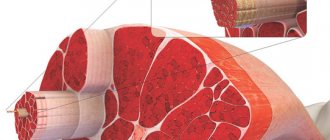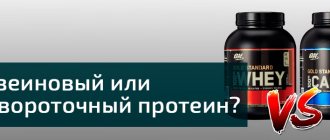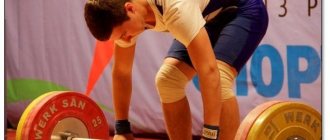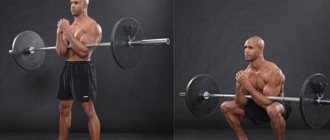All types of physical activity are divided into aerobic and anaerobic. The latter will be discussed in this article. Hercules would not have accomplished so many feats if he had not developed anaerobic strength. And there are many similar examples. What is it? This is a special type of physical activity, including exercises and elements that are performed with the participation of energy obtained in an oxygen-free way.
Anaerobic training is presented in various sports areas, where it is assumed to perform an increased load in a minimum time period.
Theory
Aerobic and anaerobic exercise. What is the difference?
These definitions show how the body obtains energy for movement. Energy is released by the breakdown of ATP (adenosine triphosphate), a substance that is synthesized by the body from nutrients. Synthesis can occur with the participation of oxygen or without the participation of oxygen. In the first case, this is called aerobic metabolism, in the second - anaerobic .
A more natural and efficient process for the body is the "oxygen" or aerobic method of ATP synthesis. It can last for a long time, does not harbor any unpleasant consequences in the form of the formation of lactic acid in the muscles, and is 19 times more effective than the oxygen-free method (with it, 38 ATP molecules are formed from one glucose molecule, whereas with the oxygen-free method - only 2).
In what case is the oxygen-free method used and why? If we put the answer to this question in simple language, it will be this: the anaerobic method is used in the case when the cardiovascular system does not have time to deliver oxygen to its destination, and energy is needed. Then the body does the following:
- first uses all the ATP reserves in the muscles (this is only about 2-3 seconds, since ATP is not accumulated by the body);
- then uses the substance creatine phosphate for rapid ATP synthesis (another 7-8 seconds);
- then it begins to synthesize ATP from carbohydrates (through the breakdown of glucose) without oxygen. In this case, a by-product appears - lactic acid (lactate). Under these conditions, it accumulates faster than the body can neutralize it, and after a few minutes the anaerobic (lactate) threshold occurs, which is expressed in burning muscles, pain and fatigue. Even if you continue some movements, their intensity decreases due to fatigue, while the heart begins to beat faster, delivering oxygen to the cells more quickly. Thus, after some time there is a forced automatic transition to ATP synthesis with the participation of oxygen.
This means that anaerobic exercise is converted into aerobic exercise and that globally there is no such thing as pure aerobic and pure anaerobic exercise. In a generally simplified form, the scheme is as follows: with the beginning of any movement, the body uses existing and rapidly synthesized ATP, if during these 10 seconds it manages to supply oxygen to the muscles, the load becomes aerobic, if not, it will remain anaerobic. But after some time, either the movement stops, or as a result of an increase in heart rate and a decrease in intensity due to fatigue, the load will still become aerobic.
What is anaerobic training used for?
Some experts say that it is “oxygen-free” loads that allow you to achieve high levels of strength and endurance. In addition, they speed up the process of losing weight compared to aerobic training. Provided the load is applied properly. In any case, through anaerobic exercise you can:
- Increase and strengthen the muscular system. Experts believe that it is “oxygen-free” exercise, coupled with proper nutrition, that can give the body the desired relief and enhance the attractiveness of its shape.
- Improve metabolic processes occurring in the body. Aerobic exercise builds muscle and speeds up metabolism, which allows you to quickly burn fat on your belly and other problem areas. However, a person loses weight with them more slowly than with anaerobic ones. Therefore, ideally it is better to combine these two types of training.
- Increase the body's endurance and strength, as well as strengthen its resistance to fatigue and the accumulation of biological poisons.
- In general, improve your health: correct your posture, speed up the removal of toxins, make your bones stronger, and at the same time reduce the risk of injury in everyday life, improve your body’s health and prolong your life.
For burning fat
Many people believe that the best method for losing excess weight is cardio training, but this opinion is wrong. With the right approach and a professionally designed training program, it is “oxygen-free” exercise that allows you to quickly cope with extra pounds without exhausting diets and harm to your health. This is achieved by improving the metabolism carried out in the body when performing these workouts.
“Oxygen” loads burn calories unnecessary for the body only during training. While anaerobic ones burn fat long after the end of training. It should be remembered that as muscle increases, the amount of calories consumed increases. Therefore, the more the muscles are loaded, the more effective the next workout will be.
You should not strain your body too much and give it an unbearable load to lose weight, otherwise injuries and pain may appear, due to which you will have to give up training altogether.
To strengthen and grow muscles
The first thing you start to think about when it comes to strength or anaerobic training is the growth and strengthening of the muscular system, and this is not surprising. After all, everyone knows that the most effective method to build muscle mass is to use strength training. Muscles are able to withstand heavy loads, and increasing their endurance has a beneficial effect on the entire body.
However, only those muscles that were affected when performing the techniques will grow. Don't forget about protein, which is necessary for muscle growth and recovery. If there is a deficiency of substances necessary for the body, working muscles will be strengthened due to those that did not take part in the training, which will affect the asymmetry of the figure.
Types of aerobic and anaerobic exercise
If you carefully read the previous paragraphs, then it will not be difficult for you to determine the predominant type of load in a particular sport. Explosive, sharp, fast active movements, lifting significant weights - all this will trigger the process of anaerobic metabolism. Lighter and longer loads - first some time of anaerobic metabolism, and then aerobic metabolism.
Bodybuilding and 100-meter sprint races are predominantly anaerobic exercise. Long-distance running, cycling, swimming - mostly aerobic. However, a bodybuilder lifting a 2-kilogram dumbbell for 100 reps or sluggishly running a 100-meter sprint would be moderate-intensity aerobic exercise, while the acceleration of cycling or running would engage anaerobic metabolism for a time.
Aerobic sports
- Swimming
- here, during training and performances, the muscles of both the upper and lower parts of the body are involved. During swimming, the joints are not overloaded, there is no need to support your own weight. Therefore, the likelihood of injury to the skeleton and muscles is reduced to zero. - Skiing
is the most advanced type of aerobic physical activity. Many muscles are involved here. As a result, the degree of aerobic fitness increases. The effect of such activities is further enhanced by the additional mass - equipment and clothing. Special exercise machines that simulate skiing help you actively burn extra calories, which means you can quickly lose those hated kilograms of weight. - A simulator
that simulates climbing stairs - almost every modern gym has such an active assistant in the fight against excess weight. During training on assistant simulators, the muscles of important parts of the body are involved - we are talking about the back, buttocks and legs. As a result, it becomes possible to provide an impressive level of energy consumption in a short period of time. - Aerobic dancing
- in such trainings you perform rhythmic movements to a fairly fast melody. To increase the intensity of the load, benches are used. Their height ranges from fifteen to thirty centimeters. Combined with other workouts, these aerobic exercises will help get rid of fat accumulation. -
strength training Here you alternately train on various training assistants for 15–20 seconds. If the classes are structured correctly, you can quickly notice positive results in the functioning of the heart and blood vessels. Muscle tone is strengthened and increased, and a sufficient number of calories are burned. - Jumping rope
is an intense type of physical activity that can be a real assistant in losing weight. - Jogging in place
, on a mini-trampoline - this type of aerobic activity should be used in the initial phase of training. Later, intense activities are more appropriate. - Aqua aerobics
- exercises performed in water. Exercises help you lose weight if you take an integrated approach to this goal.
What is the main and most vital effect of this type of activity? The answer is quite simple - increasing muscle strength.
Practice
In order to eliminate misunderstandings and unnecessary doubts and questions, we offer a practical approach on our website and divide all physical activity into 3 types according to a more understandable purpose:
- exercises to strengthen the cardiovascular system (they are also cardio, they are mainly aerobic, they, first of all, promote fat burning and weight loss) - they will be discussed in this article;
- exercises to increase strength and maintain muscle tone (they are also predominantly anaerobic);
- Exercises to develop flexibility can be both aerobic and anaerobic. Basically, like all of the above, it’s a mix.
How is aerobics different from aerobic exercise?
To help you better understand the topic, I suggest you familiarize yourself with two opposing types of exercise: aerobic and anaerobic.
What is anaerobic exercise?
To perform exercises or physical work, a person needs energy. One way it is produced is through the oxidation of glucose in the body, which is called glycolysis. As a result, pyruvic acid is formed. The process consists of a series of reactions that release energy, which is used by the muscles.
The body can survive on this energy for a short period: about five minutes, until the supply of glucose in the blood and glycogen in the liver and muscles is used up.
In addition, a by-product is formed - lactic acid, which the body needs to remove. Therefore, in order for the muscles to continue working, a break is required.
This load is called anaerobic. This type of training is carried out in a “start-stop” mode: active periods are followed by rest. Boxers and football players, for example, train using a similar method.
Anaerobic training helps build muscle mass, and the body gets used to accumulating glycogen, which “burns” during exercise. Therefore, a person can eat large amounts of food without gaining weight.
Aerobic exercise
The body has another way of generating energy. This is achieved through the oxidation of fats, carbohydrates and proteins: they break down into simpler substances, which is called catabolism.
Oxygen takes part in these reactions. Physical activity that uses such energy is called aerobic.
This is important When performing exercises, aerobic processes do not turn on immediately, but only after a certain time after the start of training, when the supply of glucose and glycogen in the body is developed. This moment is easy to determine by breathing and other signs. When you start running or working out on exercise equipment, for some period you will not feel much stress on your muscles; your breathing and pulse will change slightly
But as soon as you exercise a little, you will begin to feel that the muscles are offering some resistance to movements, the body is filled with warmth, breathing intensifies, and sweating appears. This is the aerobic mode turned on
When you start running or working on exercise machines, for some period you will not feel much strain on your muscles; your breathing and heart rate will change slightly. But as soon as you exercise a little, you will begin to feel that the muscles are offering some resistance to movements, the body is filled with warmth, breathing intensifies, and sweating appears. This turned on the aerobic mode.
During this period, lactic acid is also formed. But with the right load, it does not have time to accumulate and is removed from the muscle tissue in time.
This is interesting
- Stretching after a run - stretching exercises before and after running
- Which heart rate monitor is better to choose? Bluetooth heart rate monitor for running
The intensity of aerobic exercise is lower than anaerobic exercise, as it is limited by certain factors:
- The rate of catabolism of carbohydrates, fats and proteins.
- Limiting the supply of oxygen needed by muscles. Its quantity is limited by the capacity of the lungs, which inhale air, and the circulatory system, which delivers O2 to the muscles. The body's intentions to meet its oxygen needs are indicated by faster and deeper breathing, as well as an increase in blood pressure and heart rate.
Aerobic training is long-term exercise. Popular ones are long-distance running, long walking, cycling, swimming, skating or skiing.
Aerobics also belongs to this type of activity. It is usually carried out in groups.
Benefits of Aerobic Exercise
Typically, the source of energy for aerobic exercise is fat, which is stored in the body. But with systematic exercise, obesity does not occur, since the fat is “burned” in the following sessions.
Benefits of aerobic training:
- Lung volume increases.
- The heart muscle becomes more powerful, and the pulse becomes more stable and less frequent.
- Blood pressure normalizes and blood supply improves.
- Red blood cells that carry oxygen molecules are produced more intensively in the blood.
- The functioning of the nervous system is stabilized. This is an excellent prevention of nervous disorders.
In addition, as with any sports activity, muscles, ligaments, and skeletal bones are strengthened.
This is interesting
- Karvonen formula for calculating fat burning heart rate
- Polar is the best heart rate watch for running. Overview of the Polar range
The benefits of aerobic exercise
The main goal of aerobic exercise is to train and strengthen the cardiovascular and respiratory systems. The practical goal is to burn excess calories and get the body into good athletic shape.
In addition, during aerobic exercise the following positive changes occur in the body:
Improved blood condition:
Reducing the risk of other diseases:
- increasing bone density – reducing the risk of osteoporosis;
- strengthening muscles – reducing the risk of injury;
- cleansing of waste and toxins through sweating - reducing the risk of cancer, diabetes and other diseases.
Improvement in general condition:
- improved appearance, increased vitality;
- improved mood and mental state;
- reducing stress levels, preventing depression;
- improved sleep, general health;
- increased endurance, decreased fatigue.
What types of aerobic exercise are the best?
This question has a clear and unambiguous answer: those as a result of which your pulse is at least 20 minutes (according to the basic norm of our program - 30 minutes, and if you need to lose weight, then 40-50 minutes), stays within the range of 60% to 90% of your maximum heart rate or maximum heart rate (MHR). If the pulse is less than 60%, it should not be considered a load, if more than 90%, then it will be considered a load, but it is dangerous for your heart, especially for poorly trained people.
There are different methods and tables for determining MHR. The easiest way to determine MHR is to subtract your age from 220. If you are 20, then MHR = 200, if 40, then 180, etc.
If you have special gadgets that automatically measure your pulse, for example, a smart watch, then everything is very simple. Firstly, they themselves will determine the MHR based on your profile data and average heart rate readings over a certain period. They will set their own heart rate zones. But you can participate in this. We recommend that you install the following zones:
- Zone 1 – initial level, warm-up (we do not consider it a load) – 50-60% of MHR
- Zone 2 – light, comfortable load – from 60 to 70%.
- Zone 3 – optimal aerobic activity – from 70 to 80%
- Zone 4 – high load, threshold value – from 80 to 90%
- Zone 5 is the maximum, acceptable only for short periods - from 90 to 100%.
Zones 2-4 are exactly those indicators within which your heart rate should be for 20-50 minutes, depending on your goals. If the goal is to strengthen the cardiovascular system, health and improve the quality of life, then 20-30 minutes in zone 3-4. If the goal is weight loss, then 40-50 minutes a day in zone 2-3. However, you will lose weight with the first option, as well as improve your health with the second. It is important to do all this regularly and with pleasure.
In the case of a smartwatch, the gadget will give you the results at the end of your workouts. The photo shows the results of our “bad” workouts: too relaxed and too intense!
The watch can be configured so that when entering the fifth zone, it will emit a sound and vibration signal, informing you that it is advisable to reduce the load level.
If you decide to purchase such a gadget, then we recommend Garmin as one of the undisputed leaders in this matter. Official representatives of Garmin in Russia are our partners and will be happy to provide you with a significant discount when you enter our promotional code. You can receive a promotional code by registering.
What about those who do not have the money or desire to purchase such a device? Firstly, there are a large number of free applications for smartphones, including those that measure heart rate. They are not as convenient to use as a watch, they are not as accurate, everything does not happen entirely automatically, but... for modest workouts that do not pretend to break records, this may be enough.
If you don't have a smartphone, use a regular stopwatch. Measure the distance (from 4 to 8 km for running, skiing, fast walking, from 10 to 20 km for cycling) and record the results, trying to gradually run/walk, cover the same distance faster. Or walk for 30 minutes, trying to run/ride further each time. In the absence of automatic gadgets, your assistants should be intense sweating and difficulty breathing. If this is not the case, then, apparently, you are not doing an aerobic workout, but taking a walk in the park.
Another good option is to use a treadmill and exercise bike, especially if they have a built-in heart rate monitor.
Focusing on various expert opinions and our own experience, we offer you our rating of the most useful and effective aerobic exercises. We pay special attention to the fact that we do not claim absolute objectivity - all types are good if the condition described above is met (pulse for at least 20 minutes at a level of 60-90% of MHR). So:
- Classic cross-country skiing. The best aerobic exercise. There is a minimum of injuries, the whole body is actively involved, there is no significant load on the spine and knee joints, as when running.
- Correct Nordic walking. Exactly the correct one, with the active involvement of the upper body in the work, and not just rearranging the poles at the level and behind you. Engaging the muscles of the upper body relieves the lower extremities and gives an excellent workout to the whole body.
- Swimming. Excellent load, without injury, perfectly develops all major muscle groups. By the way, Garmin watches work great in water, giving the same complete statistics at the end and during training. There is one “but”: according to widespread expert opinion and personal experience, the process of losing weight is slower than when training on land. Therefore, if the main goal is weight loss, then it is better, in addition to swimming, to include other types of aerobic exercise.
- Bike. Ideal for training the respiratory system and lower limbs without putting excessive stress on the joints.
- Run. A very effective aerobic exercise, during which it is difficult to “net”, unlike the above, but less useful than the previous ones for the spine and joints, primarily for the knees.
We have described here the simplest and most affordable options. If you come to the fitness center, you will be offered a wide variety of programs that effectively combine the required level of aerobic and anaerobic exercise. Compound exercises are most effective for burning fat and getting in good shape quickly.
If you love team sports and think that you have a sufficient level of exercise, since you play football, basketball, volleyball, tennis, etc. 2-3 times a week. then we are afraid that you may be wrong. Recreational play may not provide the required level of aerobic activity, and we strongly recommend testing yourself. How to do it? There are two options.
The ideal way is to use a smartwatch. By the way, the photo above shows the results of a football game. The game lasted 1 hour 15 minutes, the clock was set to auto-pause when the player stopped. Thus, from the statistics it is clear that the player was actively moving for 55 minutes (the sum of all minutes on the clock); Accordingly, he stood or moved very slowly for about 20 minutes, was in zones 2-4 for 41 minutes, and in maximum zone 5 for 14 minutes. From the point of view of the amount of aerobic exercise, everything is excellent here. However, 14 minutes in the maximum zone is not very good. So team sports are fraught not only with underperformance, but also with the risk of overdosing the load.
The second way is to test yourself at least once a week, using cyclic types of aerobic physical activity and comparing them with any available and adequate indicators, for example, GTO standards, Cooper test, Tecumseh test, etc. If you do not meet the standards for your age according to these indicators, you should think about and include cyclic aerobic training in your weekly program. Well, or participate in your games more actively.
Types of workouts
Depending on the source of energy for the muscles, as well as the heart rate and goals of the exercise, sports disciplines can be either aerobic or anaerobic. Let's look at each type.
Aerobic training
Exercises or full-fledged sports activities performed at a relatively low intensity. In this case, oxygen acts as the main element in maintaining energy balance. During such training, rapid aerobic breathing occurs, which strengthens the cardiovascular and pulmonary systems.
Aerobic training usually means cardio exercise. With the participation of oxygen, glycogen reserves in the muscles and liver are consumed in 25–30 minutes. After this, the body begins to gradually “burn through” fats. Therefore, to achieve sustainable weight loss, aerobic training should last at least 45-50 minutes.
In addition to getting rid of extra pounds, cardio has the following benefits:
- increasing the body's endurance;
- improved digestion;
- normalization of sleep;
- maintaining the level of “good” cholesterol;
- strengthening the myocardium;
- increased muscle tone;
- relief of depressive conditions.
It is recommended to conduct aerobic exercise in the fresh air, as this increases the consumption of pure oxygen and improves the overall well-being of the athlete. The pace of training is selected individually. But most often, such exercises are carried out in the average pulse zone, corresponding to 55–65% of the maximum heart rate.
Cardio training is very diverse. This is due to its effectiveness in losing weight and tightening muscles. There are entire disciplines built specifically on aerobic exercises. Examples of such physical activities are:
- run;
- a ride on the bicycle;
- race walking;
- working on cardio equipment;
- aerobics;
- aquafitness
The advantages also include accessibility to a wide range of people. Regardless of training and age, anyone can choose the appropriate type of training. For example, older people use orbitrek to protect their knee joints. And for those who have problems with the spine, exercise in the pool or on a bicycle ergometer is suitable.
Aerobic training has medical contraindications. Most often they are associated with diseases of the respiratory system and heart. But besides this, cardio exercises should be used with caution by obese people. It is not advisable to exercise during pregnancy, after abdominal surgery, or with injuries to the musculoskeletal system.
Anaerobic training
Exercises or full-fledged sports activities carried out at high intensity. Muscle work occurs due to the processes of anaerobic glycolysis, that is, under conditions of low oxygen consumption.
Such training can take from 45 minutes to 2–3 hours (for trained athletes).
Anaerobic training is mostly strength training. Therefore, their main functions are:
- increasing the athlete’s strength characteristics;
- increase in muscle mass;
- development of explosive speed.
The lesson itself is based on complex loads on the whole body. The structure of each approach: 6–10 repetitions in basic exercises and 10–12 in isolating exercises.
In addition to increasing strength and increasing muscle mass, anaerobic exercise has the following positive properties:
- strengthening ligaments, tendons, joints;
- formation of a harmoniously developed figure;
- reduction of body fat;
- acceleration of metabolic processes;
- stimulation of the hormonal system;
- getting rid of depression.
As a rule, a training program for beginners is designed so that anaerobic exercises affect all parts of the body in one visit to the fitness room. Professionals practice on a different principle - split (sharing of loads) - each workout is aimed at working two or three large muscles. This allows for better muscle development.
An important feature of intense strength training is the combination of short sets and pauses. Since an athlete cannot train for a long time in a state of anaerobic threshold, approaches are performed for 20–30 seconds. Afterwards there is always a pause for recovery. This is necessary so that the body has time to reduce the lactate content in the muscles.
People who are far from sports assume that anaerobic training refers to exercise in the gym: powerlifting, bodybuilding. This is only half true. Strength training also includes:
- crossfit;
- HIIT;
- tabata protocol;
- plyometrics;
- weight-lifting;
- arm wrestling;
- weightlifting;
- workout
Since most exercises in strength disciplines are performed with weights, this imposes certain requirements on the athlete’s health. First, there should be no untreated injuries or genetic abnormalities (for example, scoliosis). Secondly, it is unacceptable to perform strength exercises with heart failure.
Duration and frequency of aerobic training
In the previous paragraphs we already said that a lot depends on your goal. If the goal is to improve health, then the ideal option would be 30 minutes daily of any physical activity with a heart rate in the zone of 60-90% of the maximum. In total, we recommend 3.5 hours per week in our basic program. If your goal is weight loss, then it is better to divide 3.5 hours into 4 times of 45-55 minutes, and on free days spend more time on strength training. The fact is that, as a rule, in the first 20 minutes of an aerobic workout, your body uses carbohydrates for fuel and switches to fats later. Therefore, if you run for 20 minutes every day to lose weight, the effect will be insignificant.
Please note that if you do not use a heart rate monitor with its accurate indicators, we recommend adding approximately 3-5 minutes to your training time to ensure that your heart rate enters the required load zone.
Aerobic development zone (aerobic threshold zone).
ATP resynthesis occurs primarily through aerobic oxidation. Also in a small proportion there is a component of glycolytic energy supply. Motor activity is carried out to a greater extent by the MMV, however, as the intensity approaches the upper boundary of the zone, fast muscle fibers (type A FMV) join them. BMW type A has a lower ability to process lactate than MMV, so its level rises slowly. Within this zone there is the so-called aerobic threshold (AT), indicating the level of load at which the processes of glycolysis begin to turn on and actively function, increasing the content of lactic acid salts in the tissues and blood.
Heart rate 160–175 beats/min. Blood lactate increases to 4.5 mmol/liter. Oxygen consumption 60–90% MIC. The main substrates are carbohydrates - glycogen and glucose, fats are less actively involved.
Training in this zone develops special endurance, and it is also possible to work on coordination and flexibility. The training method is continuous (including cyclic). The development of the cardiorespiratory system is stimulated. The execution time also ranges from a few minutes for an interval approach to training to several hours for a continuous method. The intensity is moderate. The degree of intensity varies depending on the method.
It is used in preparation for sports games and marathon running. With prolonged exercise in this zone, due to the release of heat during oxidative reactions, body temperature increases, which places demands on the development of thermoregulation systems.
Nutrition during aerobic exercise
Read more about nutrition in the relevant articles from the “Healthy Eating” section and in the “Ideal Day GREENPORTAL.pro” article. Here we will briefly say that the correct way would be to eat carbohydrate foods before training and protein-carbohydrate foods after. If you eat food 30-40 minutes before training (as a rule, this happens if you train in the morning), then the best option would be a small snack with foods with an average glycemic index - so-called fast carbohydrates, for example, bananas. The ideal option, which we recommend in the morning, half an hour before training, is a green smoothie.
If the workout is in the evening, then consume a good supply of slow carbohydrates 1.5-2 hours before it - buckwheat, brown rice, durum wheat pasta. You will need them to conduct your classes effectively.
Keep in mind that after aerobic exercise, the body continues to actively break down fats and carbohydrates for some time. This process lasts about 2 hours. If at this moment you consume some quick source of energy - the same banana - then this process will stop. Therefore, if your goal is to lose weight, then try not to eat anything for 2 hours after training. If there is no such goal, then proteins in combination with slow carbohydrates (60 to 40) are an excellent option within 30-40 minutes after training. If you are planning to lose weight, but cannot withstand 2 hours without food, then a better option would be predominantly protein foods, for example, dairy and fermented milk products, a small piece of fish or poultry with a side dish of fresh vegetables.
Parting words
We thank you for reading the article, but... without further action, the theory is meaningless. Go outside and run, swim, move actively in any way possible. 20-30 minutes a day - and your body will thank you with excellent well-being and good health until old age! Register on the site and start entering data into the program. Share your results, observations, and feelings on social networks! It's stimulating and inspiring!
Have a good physical activity and enjoy your relaxation afterwards!
Good luck!
Team











